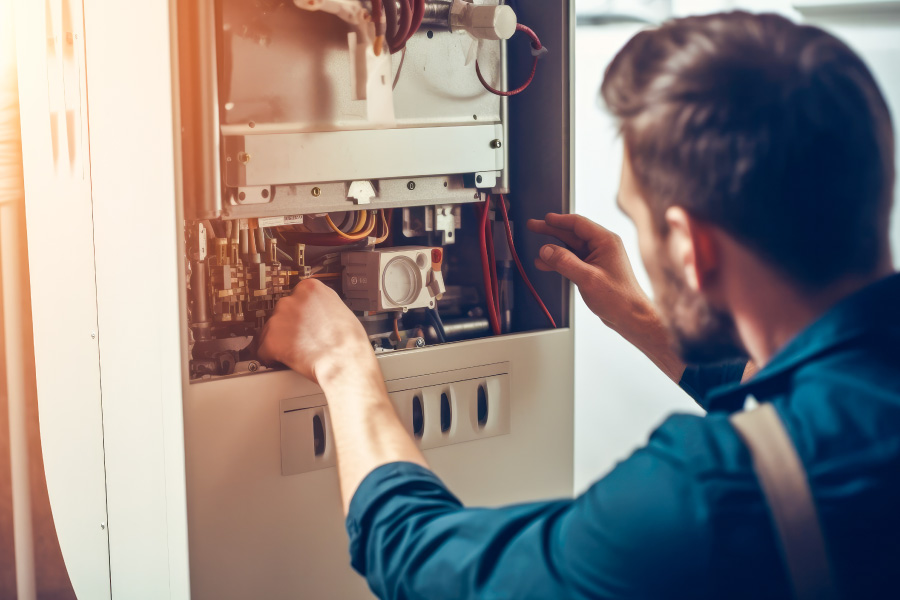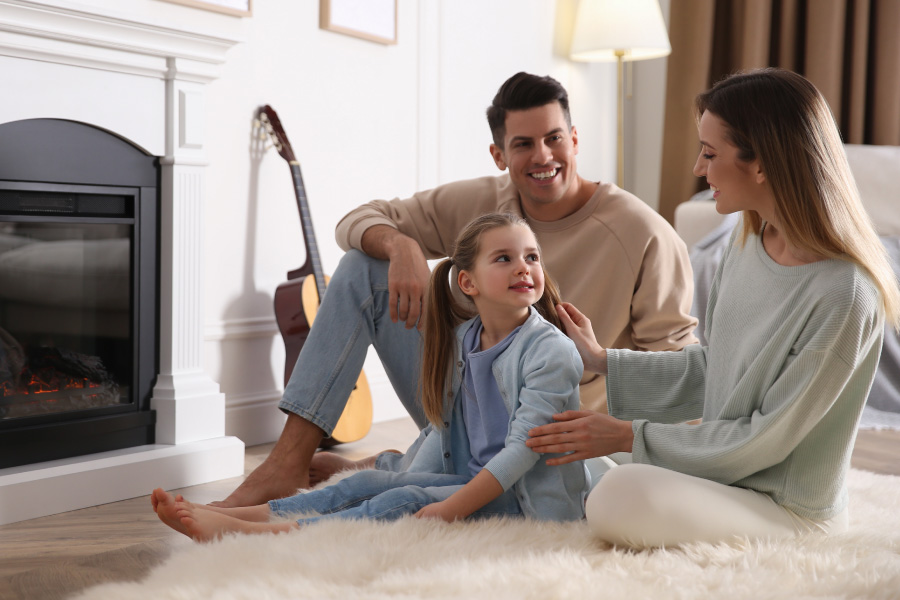
Heating and Cooling Solutions
If you’re a Bozeman homeowner, you may have noticed that summers here seem to be getting hotter. That’s because the Department of Environmental Protection reports Montana is getting warmer by about 2°. This rise in temperature may have you considering air conditioning installation in your home.
If you’re deciding which air conditioner is right for your house, one important factor you should consider is the air conditioner’s size. Choosing an improperly sized air conditioner for your home, whether too large or too small, can increase your long-term costs due to inefficient cycling or continuous operation. Read on as we explain why air conditioner size matters and how to choose the best air conditioner size for optimal comfort and energy efficiency.
Consequences of Choosing the Wrong Air Conditioner Size
Sizing is key when deciding which air conditioner is right for your home. Size, in this situation, does not refer to the actual size of the air conditioner unit. Instead, it relates to the air conditioner’s cooling ability and how much power it takes to cool your home. Selecting an incorrect air conditioner size can lead to inadequate cooling of your home and sky-high energy bills. Here’s a quick look into these consequences:
- Poor Cooling and Overworking: An undersized AC unit will struggle to cool your home effectively, running continuously in an attempt to reach the desired temperature. This not only leads to insufficient cooling but also excessively wears out the unit, potentially leading to premature failure.
- Excessive Energy Consumption: On the other hand, an oversized AC unit cools the home too quickly and shuts off, which is known as short cycling. This frequent on-and-off operation requires more energy and can significantly increase your electricity bills. It also prevents the unit from dehumidifying the air properly, leaving your home feeling damp and clammy.
How Do You Determine the Right Air Conditioner Size for Your Home?
To determine the correct air conditioner size you need for your home, your Bozeman HVAC contractors will perform a load calculation on your home when you schedule an appointment. A load calculation is a comprehensive assessment of your home cooling needs that evaluates your home’s insulation levels, window types and locations, and how many people live in your home. It even takes into account Bozeman’s climate, which can impact your cooling needs. In assessing these factors, our air conditioning expert technicians can easily identify the best air conditioner size and product for your home. Proper sizing not only ensures optimal cooling but also promotes energy efficiency and cost savings in the long run. And if your existing air conditioning system breaks down and needs repair or maintenance, our certified professionals repair all major brands of air conditioners. Contact us and schedule an appointment; we have you covered!
Debunking Common Air Conditioner Size Misconceptions
There are a few misunderstandings when it comes to air conditioner sizing. As air conditioning experts, we hope to dispel these misconceptions and guide you in installing the best air conditioner for your home needs.
- Myth: “Bigger Is Always Better” – When it comes to AC units, bigger is not always better. An oversized unit leads to short cycling, inefficiency, and home discomfort due to poor humidity control.
- Myth: “The Square Footage Rule of Thumb Is Sufficient” – Relying solely on the square footage of your home to determine air conditioner size ignores other critical variables such as insulation, window size, and Bozeman’s climate. These factors are all necessary in choosing the correct air conditioner size.
- Myth: “Energy Efficiency Is Only About the AC Unit’s Rating” – While the energy efficiency rating of an AC unit is important, the unit’s size and how well it matches your home’s needs are also important for actual energy savings.
Benefits of a Correctly-Sized Air Conditioner
Choosing the proper air conditioner size for your home will help you maximize the overall efficiency and comfort of your home, ensuring the longevity of your HVAC system. Here are a few of the top benefits of a correctly-sized air conditioner:
- Enhanced Comfort: A correctly sized AC provides consistent cooling and humidity control. Balanced cooling ensures that every room in your home remains at your desired temperature, offering a cool sanctuary from Bozeman’s summer heat.
- Balanced Airflow: Properly sized AC units ensure efficient airflow, distributing cool air evenly and preventing hot spots or uneven cooling, which can be common issues with improperly sized systems.
- Reduced Energy Bills: An AC unit that matches your home’s cooling load operates more efficiently and uses less energy to maintain comfort. This efficiency translates into lower monthly energy bills, providing cost savings over the system’s lifespan.
- Prolonged Air Conditioner Lifespan: When an AC unit operates under optimal conditions, it experiences less wear and tear. This not only enhances performance but also extends the lifespan of the system, ensuring years of reliable cooling.
Need Help Deciding the Right Air Conditioner Size for Your Home?
Understanding the importance of air conditioning size is more than a matter of comfort; it’s about optimizing energy use, reducing energy costs, and ensuring your home operates efficiently. At Mountain Heating & Cooling, we can answer all your air conditioner sizing questions and help you find the best air conditioner brands, like Trane air conditioners and others. Reach out and schedule an appointment for an air conditioning consultation today!

Heating and Cooling Solutions
If you’re a Bozeman homeowner, you may be aware of rising heating costs. According to a recent news report by Montana Right Now, it’s because “Montanans are projected to spend 13.6% more on their utility bills this winter.” Rising utility costs, public concern over energy efficiencies, and increasing environmental impact have prompted the government to incentivize home heating solutions through the Inflation Reduction Act. The Inflation Reduction Act is a federal law, which in addition to curbing inflation, also invests into domestic energy production and encourages clean energy.
At Mountain Heating & Cooling, we are home heating experts who know the Inflation Reduction Act is good news for you as a homeowner. It is the largest HVAC incentive program ever established, and it was created so homeowners could take advantage of federal tax credits and deductions to make their homes more energy efficient and reduce home energy costs. One way homeowners can do this is through heat pump rebates and tax credits. Heat pump rebates and tax credits are financial incentives offered by the government to offset the upfront cost of purchasing and installing a heat pump. The reason heat pumps are included in the act is because they are high-energy efficient heating and cooling systems.
The long-term savings associated with heat pump installations extend far beyond tax credits and rebates. Because heat pumps are highly energy efficient, they are considered one of the most cost-effective ways to heat and cool your home. They can typically save you between 30-40% on utility expenses when compared to a forced air system. Other heat pump benefits that offer long-term savings are that they can add value to your home. Heat pumps can save you an average of 30-70% on energy costs annually, and they are 2-3x more efficient than gas furnaces, which can add up to significant savings over the years.
When it comes to heat pump installation, the most important decision you’ll make is ensuring that you’re hiring the best-qualified HVAC contractor. Our HVAC professionals have extensive, ongoing training and certification so you can feel confident that your heating installation or repair goes smoothly. At Mountain Heating & Cooling, we take the time to understand your unique needs and will ensure that we help you select a home heating system that exceeds your expectations. Explore the benefits of upgrading your home’s comfort and efficiency with a heat pump.
How to Benefit From Heat Pump Rebates
Taking advantage of incentives such as heat pump rebates can help lower heating installation costs and make your home more energy efficient and cost-effective in the long run. The benefits of leveraging these rebates and tax credits when installing heat pumps include:
- Financial Savings: Rebates and tax can significantly offset the initial cost of heat pump installation. Also, heat pumps save between 30-70% on annual energy costs,adding long-term value to your home.
- Environmental Impact: Heat pumps are environmentally friendly; they do not produce carbon emissions because they do not burn fuel.
- Energy Efficiency: Heat pumps are highly energy efficient and can save between 30-40% in annual energy costs compared to a forced air system.
What Heat Pump Rebates & Tax Credits are Available to Homeowners?
According to Energy Star, which is backed by the U.S. Environmental Protection Agency, from now through 2032, “federal income tax credits are available to homeowners that will allow up to $3,200 annually to lower the cost of energy-efficient home upgrades by up to 30%.” As a homeowner, you may also take advantage of this tax credit and the Residential Clean Energy credit to get a 30% income tax credit for installing clean energy equipment, such as a heat pump, into your home.
In addition to the tax credits, you may be eligible for heat pump rebates good for up to $1,750 for a heat pump water heater and $8,000 for heat pumps for space heating and cooling. All taxpayers qualify for the tax credit program, while eligibility for federal heat pump rebate programs depends on household income level. The median household income rebate eligibility is as follows:
- Households making less than 80% of their state’s median household income are eligible for 100% of the rebates.
- Households making between 80 and 150% of the median household income of their state are eligible for 50% of the rebates.
- If your household income is equal to or greater than 150% of the state’s median, you’re not eligible for the rebates, but you still qualify for the tax credits.
Homeowners should also be aware that they can take advantage of “rebate stacking” when it comes to heat pumps. Rebate stacking is when you use multiple incentives to help lessen the upfront costs of your heat pump installation. For homeowners who qualify, using rebate stacking towards your home heat pump installation may make it nearly free. For example, a primary bedroom mini-split heat pump installation for a homeowner who earns less than $56,000 would be zero. As HVAC experts who know how to help homeowners get the most out of rebates, we know that heat rebates can change. That’s why we recommend you schedule a consultation with us and get pricing now.
How to Claim Heat Pump Rebates & Tax Credits
Also, according to Energy Star, federal tax credits for energy efficiency can be “claimed with your federal income taxes for the year in which you make your heating system upgrades.” However, before you prove your claims, there are a few things to consider:
- Claims must be made for improvements to the home you live in.
- You may not claim the tax credit if you do not live in the home because you are a landlord or property owner.
- The tax credit doesn’t apply to newly built homes.
- There are no lifetime dollar limits to the tax credits.
- You may claim the maximum annual credit for every year you make an improvement to your home through 2023.
- Tax credits are not refundable, and you can’t get back more than you owe in taxes.
- And finally, you cannot apply for excess credit for future tax years.
Instructions and Applications For Claiming Rebates & Tax Credits
- Instructions for Form 5695
- Claim using the IRS Form 5695
- For 2024 in Montana, Montana homeowners should know that details regarding point-of-sale rebates and income verification have not been finalized at this time. Homeowners can contact energy resource professionals at the Montana Department of Quality with questions regarding residential energy efficiency rebates here or contact our heat pump installation experts to answer all your rebate claim questions.
Want to Learn More Heat Pump Rebates? Ask Your Montana HVAC Experts
Installing new heating systems may cost anywhere between $6,000 to $18,000. Don’t be overwhelmed by sticker shock—you have options! One of the best ways to mitigate these expenses is to leverage heat pump rebates and tax credits. Not only will you save on heat pump installation costs, but you’ll also reap the long-term savings that energy-efficient heating systems provide.
At Mountain Heating & Cooling, we can help answer your heat pump rebate and tax credit questions so you can benefit from these savings. Reach out and schedule an appointment for a heat pump consultation today!

Heating and Cooling Solutions
Choosing the right furnace to heat your home is a weighty decision and a significant investment. From natural gas to electric to propane, there are many different types of furnaces available to choose from, and it can be hard to know which one best fits your needs. They each have unique advantages and are all wonderful heating solutions for homeowners who live in cold winter climates like ours in Montana. So how do you choose between the different types of furnaces? Don’t worry—our Bozeman furnace installation experts have your back! Read on as we help guide you through the types of furnaces and their advantages and disadvantages so you can see which type of furnace may be best for your home and budget.
What’s Best for Your Home: Explore Different Types of Furnaces
Furnaces are well known for being excellent for heating homes in freezing climates. They use natural gas, liquid propane, or electricity to heat a home quickly. Unless it’s electric, a furnace will typically burn fuel to produce heat in collaboration with a heat exchanger. The heat is then transferred throughout a home’s ductwork through forced air. The result is a warm, cozy home that heats efficiently, even on the coldest winter days.
Let’s explore a few of the different types of furnaces: natural gas and propane furnaces, and electric furnaces.
Natural Gas & Propane Furnaces
Natural gas furnaces and propane furnaces both work in the same manner; the only difference is the type of fuel. They use either natural gas or liquid propane to create warm air that is then forced through your home’s ductwork to heat your home. They work when natural gas or propane is ignited as it moves into a burner assembly. As it does this, it creates a combustion that produces heat. This warm heat then moves into a compartment where it emits warm air within the furnace. This warmed air is then pushed throughout your home’s heating system with a fan. The warm air is evenly distributed into every room in your house, keeping your home comfortable.
Pros of Natural Gas & Propane Furnaces:
- Natural gas and propane furnaces are cost-effective. In the long run, they are less expensive than electric furnaces.
- According to our trusted friends at Trane, our recommended Trane furnace brand, “gas furnaces have longer lifespans than other types of heaters, typically lasting anywhere from 20-30 years depending on usage and maintenance.”
- Natural gas and propane furnaces are cleaner for the environment, as they produce less emissions.
Cons of Natural Gas & Propane Furnaces:
- For propane furnaces, the propane needs to be stored in a tank away from the home to prevent the risk of fire and leak hazards happening inside your house.
- While you will experience cost-effective savings in the long run with natural gas and propane furnaces, the initial upfront cost of installing this type of furnace can be expensive.
- As a homeowner, you will need to stay on top of regular furnace maintenance to keep this type of furnace running smoothly, so you don’t experience furnace breakdowns or harmful hazards such as gas leaks. Regular furnace maintenance by certified professionals can help identify problems before they occur. At Mountain Heating & Cooling, we are furnace maintenance experts and offer a we’ll-be-there-today guarantee if it ever needs repair!
Electric Furnaces
Unlike natural gas and propane furnaces, electric furnaces and heat pumps do not require a type of fuel to create heat in a home. Instead, they use electricity. They do, however, work in a similar way to natural gas and propane furnaces, in that heated air is created within the unit and then redistributed throughout your house. Electric furnaces have heating elements made up of wires that are wound around coils, which are fastened within the interior of the furnace. Electricity moves through this wiring to produce heat. The heat is then transferred via a blower into your home’s ducts, which in turn heats the rooms of your home. A heat pump is an energy-efficient heating system that redistributes warm air from the outside of a home and brings it inside. It does this by pulling heat from the ground and then transferring it through a heat pump system into your home. Learn more about heat pump installation here.
Pros of Electric Furnaces:
- An advantage of electric furnaces is that they do not produce carbon monoxide like gas furnaces, so their environmental impact is less.
- Electric furnaces can operate for years. On average, the lifespan of an electric furnace can be between 20 to 30 years.
- Electric furnaces require less maintenance when compared to other types of furnaces because they do not have the fuel components other furnaces have, which require regular servicing.
Cons of Electric Furnaces:
- A drawback of electric furnaces is that electricity can cost more than the price of natural gas.
- If the power goes out in your home, there will be no electricity to run your electric furnace. This may require you to have a secondary source of heating.
- Electric furnaces can take a while to warm up a home. They are also not typically suited for cool climates because they must work harder to warm colder temperatures.
4 Factors to Consider When Choosing A Furnace
Now that you know what different types of furnaces are available for heating your home, there are a few factors to consider when choosing between them. The most important factor when choosing a furnace is to consider the size of your home. If your home is large, you will need a furnace that can produce enough heat to warm the entire square footage of your house. Next, the location of your home matters when choosing a furnace. If your home is located in a cold climate, like here in Montana, again, you will need a furnace that can handle frigid temperatures that drop below freezing. Another factor to consider is energy efficiency. Energy-efficient furnaces can save you on costs in the long run because they require less energy to heat your home sufficiently. And finally, fuel source can be a factor when choosing a furnace. Different fuel types can cost different prices; some may be more expensive than others—and some might not even be available in the location of your house. Four factors to consider when choosing a furnace:
- Size of your home
- Location of your house
- Energy efficiency
- Type of fuel
Need Help Deciding Which is The Best Furnace for Your Home?
When shopping around for the right heating solution for your home, you have many different types of furnaces to choose from. No matter whether you go with natural gas, propane, or an electric furnace, all types of furnaces can keep your home warm and cozy. They each have their advantages and drawbacks, and deciding between one or the other depends upon your particular heating needs.
Here at Mountain Heating & Cooling, our licensed technicians receive extensive furnace installation training and certification. We can help guide you through the furnace installation process so you can enjoy the peace of mind that comes from knowing we have your furnace installation under control. Reach out and schedule an appointment for a furnace consultation today!

Heating and Cooling Solutions
Anyone living in Montana should make carbon monoxide safety a top priority for their home. According to SafeWise, consumer safety experts, Montana ranks third for the most carbon monoxide poisoning-related deaths in the nation. In fact, 34% of these poisonings are due to heating systems in the home, like your furnace.
These are shocking statistics, but ones all Montanans should be aware of because we typically experience six months of winter annually. We depend on our heating systems to keep our homes warm during the colder months, but most carbon monoxide poisonings occur during the winter. Before you turn up your thermostat this winter, ask yourself this: when was the last time you scheduled furnace repair services? If it’s been a while, it’s a good idea and essential to have furnace maintenance done as soon as possible to check for CO leaks.
At Mountain Heating and Cooling, we are carbon monoxide safety experts, especially in relation to your HVAC system. We take your safety seriously, which is why preventing CO leaks is of the highest importance to us. In this blog, we share our expertise about what carbon monoxide poisoning is, what steps you can take to prevent carbon monoxide poisoning in your home, and what you can expect when we perform home furnace inspections. Read on for more information, or if you’re ready to book an inspection, schedule an appointment here or call us at (406) 586-4007.
Carbon Monoxide Safety: “The Silent Killer”
What is Carbon Monoxide Poisoning?
Commonly known as “The Silent Killer,” carbon monoxide poisoning gets this name because carbon monoxide has no odor, no taste, and is non-irritating. Carbon monoxide poisoning happens when carbon monoxide prevents your body from getting oxygen, causing a range of harmful symptoms Though it can affect people differently, low dose carbon monoxide poisoning symptoms include dizziness, shortness of breath, headaches, nausea, confusion, and heart flutters. In severe cases, exposure to carbon monoxide and high carbon monoxide poisoning levels can cause one to lose consciousness, suffer brain damage, and even die.
What To Do If You Suspect Carbon Monoxide Poisoning?
If you suspect carbon monoxide poisoning in your home, immediately follow these steps:
- Get outside of your home as quickly as possible so you can breathe fresh air.
- Call 911.
- Only if possible, as you leave your house turn off non-electrical appliances, open windows and leave doors wide open.
- Call the fire department, and do not re-enter your home until authorities tell you it is safe to do so.
5 Steps You Can Take to Prevent Furnace Carbon Monoxide Poisoning
Carbon monoxide can be emitted from many sources, but especially appliances that burn fuel, like your furnace or boiler. Our friends at Trane put together a helpful inspection checklist you can use to inspect your furnace and prevent carbon monoxide poisoning.
- Look — Visually inspect the flames of the burner in your furnace. A blue color flame indicates that the fuel is burning properly. If the flame is an orange or yellow color, this can indicate that something else besides natural gas is being burned.
- Listen — Do you hear any unusual noises coming from your furnace? Unidentifiable sounds from your heating system—such as popping, scraping, or banging—warrant a professional technician’s expertise. Our Bozeman HVAC professionals can pinpoint the source of the noise and fix any problems that are causing the issue.
- Smell — While carbon monoxide is odorless, do you smell gas leaking? If so, do not light any appliances, touch electrical switches, or even use a landline phone. Get outside quickly and call 911 from a neighbor’s house or a cell phone.
- Install a Carbon Monoxide Detector — Carbon monoxide detectors are devices, like a fire alarm, that plug into any outlet or are battery operated and can identify the presence of carbon monoxide. If carbon monoxide is detected, an alarm will sound to notify you that you should get out of the house and call 911.
- Schedule Regular Furnace Inspections — Finally, and most effectively, to ensure carbon monoxide safety, have your furnace regularly inspected by a licensed technician. At Mountain Heating and Cooling, we can identify problems before they occur and ensure you have peace of mind that your heating system is operating at its optimal best. Ben Franklin said it best:, “An ounce of prevention is worth a pound of cure.”
Benefits of Home Furnace Inspections: What to Expect?
Having your furnace inspected regularly not only prevents hidden dangers like carbon monoxide poisoning, but it just makes good sense. A well-maintained furnace can last more than 20 years, saving you time and money in the long run. Besides standing the test of time, regular furnace inspections offer many benefits, including early detection of unforeseen problems, improved furnace efficiency, enhanced indoor air quality, and saving you money on costly heating repairs.
At Mountain Heating & Cooling, we offer preferred membership agreements in Bronze, Silver, Gold, and Platinum plans so our customers can easily get the maintenance they need without worrying about hassle or expense. Here’s what you can expect during our home furnace inspections:
- To begin, we will inspect your furnace visually and ensure that any areas, equipment, or piping connected to it are free of debris or obstructions.
- Next, we’ll specifically make sure that the vent connector, the piping that carries carbon monoxide from your furnace to the outside of your home, is free from any erosion caused by corrosive gasses.
- We will then inspect your furnace’s support structure and air duct connections. We’ll look for cracks in the support and ensure that ducting is securely sealed.
- Finally, we’ll inspect your furnace’s burner flames. We will make sure that they are burning correctly and consistently without any sporadic motion or discoloration. As mentioned earlier, this can indicate that something else besides natural gas is being burned or fuel flow is being interrupted.
Our expert technicians will evaluate any furnace issues you might be experiencing and provide you with recommendations before we perform any services. No matter what brand of furnace you have or where you bought it, we have you covered!
Get Peace of Mind: Schedule Regular Furnace Maintenance
At Mountain Heating & Cooling, we are your Bozeman heating and cooling experts. Our licensed technicians receive extensive carbon monoxide safety and furnace repair training and certification. We will ensure you and your family have peace of mind, knowing that your heating system works exactly how it should. Be proactive—don’t neglect your furnace maintenance! Reach out and schedule an appointment today.

Heating and Cooling Solutions, Service
Furnaces are a worthwhile investment, but, like any homeowner, you want to get the most value and use out of your furnace. To avoid spending money on a new furnace too soon, you can save thousands of dollars with annual furnace maintenance. Regular furnace maintenance helps identify heating repairs before your furnace ever breaks down. It can extend the lifespan of your furnace and maximize your comfort and budget in the long run because it helps your furnace consistently operate at peak performance.
At Mountain Heating & Cooling, we’re your Bozeman HVAC experts and know how to keep your furnace running smoothly with annual furnace maintenance. Read on as we explain how furnaces work, what can happen if furnace maintenance is neglected, steps you can take to prevent your furnace from performing poorly, and the benefits of staying on top of regular furnace maintenance.
Annual Furnace Maintenance: Keep Your Home Warm & Cozy
Furnaces & Their Advantages
In Bozeman, Montana, furnaces are an excellent heating solution for your home. A furnace works by burning propane or oil to quickly produce heat in collaboration with a heat exchanger inside the furnace unit. The heat produced from combustion within the heat exchanger is then transferred throughout a home’s ductwork through forced air. The result is a warm home that stays evenly and efficiently heated.
In addition to warming your home quickly, furnaces have many benefits that make them a good option for home heating, such as::
- They are energy efficient and can save costs on your utility bills.
- Filtration systems within a furnace can help improve air quality and reduce allergens within your home.
- Newer furnaces use less fuel or can be electric, making them an environmentally friendly heating option.
The Cost of Neglecting Your Furnace
Furnaces are known for having long lifespans. A well-maintained furnace has more than 20 years of longevity, so, typically, there is no need to worry about replacing it anytime soon. However, furnaces can break down if they are not maintained, costing homeowners a pretty penny in furnace repair services. If the neglect is extreme, a homeowner may have to invest in an entirely new furnace.
Here’s what can happen if you fail to properly maintain your furnace:
- Overlooked furnaces have decreased energy and operating efficiency because they must work much harder to heat your home.
- Neglected furnaces operate inefficiently, so they have to constantly run to maintain your home’s warmth. This can cause your monthly energy bills to soar.
- In the worst-case situations, a furnace that is not regularly maintained can become a safety hazard, causing issues like carbon monoxide leaks. Every year thousands of people end up in the ER due to carbon monoxide poisoning.
Fortunately, most furnace problems are preventable if you take proactive steps.There are several actions you can take to help avoid furnace troubles.
Steps to Prevent Poor Furnace Performance
If you want to keep your furnace performing at its best, here are a few boxes you can check off to prevent potential furnace issues:
1. Change Your Air Filters Regularly
Furnaces use air filters to remove impurities such as debris and pollutants from the air before it is filtered into your furnace. Clogged air filters can damage your furnace’s compressor and keep your HVAC system from running correctly. We recommend changing your furnace air filter every one to three months. It is best to change 1″ filters every month and 4″ filters every three months. If you need assistance changing your air filters, don’t hesitate to reach out to our team of professionals—we’re here to lend a hand with your HVAC needs!
2. Check Your Furnace’s Air Ducts and Vents
If visible, make sure your air ducts are securely fastened together. Look for any loose connections, cracks, or moisture buildup. Excess moisture on air vents can indicate a more serious problem, such as growing mold, which can be hazardous to your health and require immediate professional service.
When inspecting your vents, look for dust buildup. You can easily remove vent covers and vacuum them clean. Doing so will help improve your home’s air quality. However, it is a good practice to have a professional HVAC technician do a deep cleaning and inspect your home’s entire air duct and vent system at least every other year.
3. Stay on Top of Annual Furnace Maintenance
Have your furnace inspected by a certified Bozeman heating and cooling professional. Trained technicians can often spot malfunctions that might not be common to an untrained eye. It can save costs by identifying furnace problems before they become furnace disasters. At Mountain Heating & Cooling, we offer preferred membership agreements in Bronze, Silver, Gold, and Platinum plans so our customers can easily get the maintenance they need without worrying about hassle or expense.
Benefits Of Scheduling Annual Furnace Maintenance
Scheduling annual furnace maintenance has benefits every homeowner should take advantage of. By proactively caring for your furnace, you are ultimately ensuring your home stays comfortable all year round. It also minimizes the likelihood of unexpected breakdowns or unwelcome emergencies you may encounter. Regular maintenance of your furnace can save you both time and money over the lifespan of your heating system.
7 Advantages of Regular Furnace Maintenance:
- Increases the longevity of your furnace investment.
- Ensures maximum airflow to each room.
- Reduces chances of costly future replacements.
- Improves energy efficiency, which reduces your utility bill.
- Keeps you and your family safe from hazardous situations.
- Reduces in-home allergens.
- Keeps you warm and happy during Montana’s cold winters.
Ready To Schedule Furnace Maintenance?
At Mountain Heating & Cooling, we are your Bozeman heating and cooling experts. Our licensed technicians receive extensive furnace installation and repair training and certification. Our team of professionals will ensure that your furnace runs smoothly and safely so you have peace of mind. Don’t put it off; reach out and schedule an appointment today. We have you covered!





